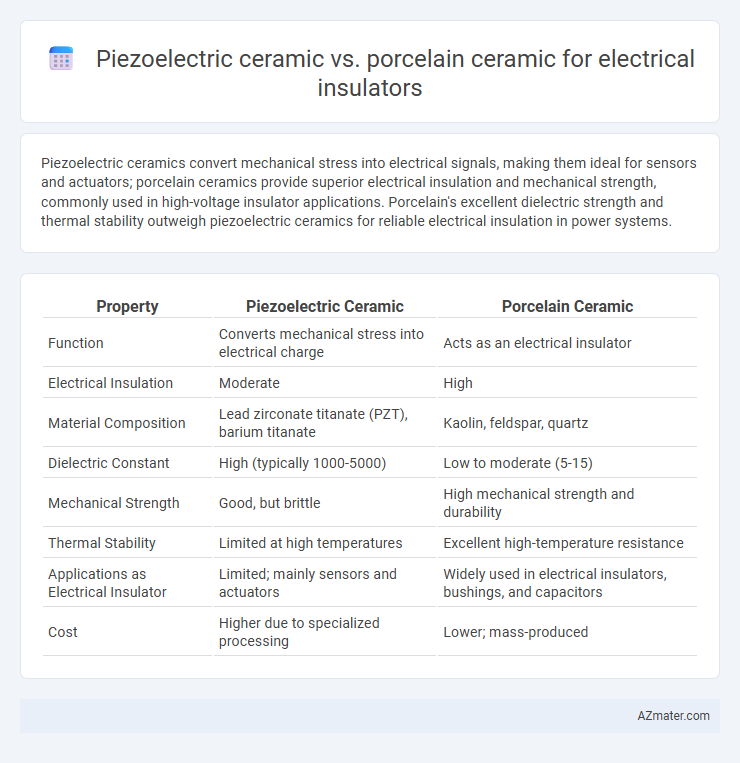Piezoelectric ceramics convert mechanical stress into electrical signals, making them ideal for sensors and actuators; porcelain ceramics provide superior electrical insulation and mechanical strength, commonly used in high-voltage insulator applications. Porcelain's excellent dielectric strength and thermal stability outweigh piezoelectric ceramics for reliable electrical insulation in power systems.
Table of Comparison
| Property | Piezoelectric Ceramic | Porcelain Ceramic |
|---|---|---|
| Function | Converts mechanical stress into electrical charge | Acts as an electrical insulator |
| Electrical Insulation | Moderate | High |
| Material Composition | Lead zirconate titanate (PZT), barium titanate | Kaolin, feldspar, quartz |
| Dielectric Constant | High (typically 1000-5000) | Low to moderate (5-15) |
| Mechanical Strength | Good, but brittle | High mechanical strength and durability |
| Thermal Stability | Limited at high temperatures | Excellent high-temperature resistance |
| Applications as Electrical Insulator | Limited; mainly sensors and actuators | Widely used in electrical insulators, bushings, and capacitors |
| Cost | Higher due to specialized processing | Lower; mass-produced |
Introduction to Electrical Insulators
Electrical insulators, such as piezoelectric ceramic and porcelain ceramic, play crucial roles in preventing unwanted current flow in electrical systems. Piezoelectric ceramics offer unique properties by converting mechanical stress into electrical signals, making them ideal for sensors and actuators, whereas porcelain ceramics provide excellent dielectric strength, mechanical durability, and resistance to high voltages, commonly used in power distribution and transmission. Both materials serve distinct functions in insulation applications, with porcelain excelling in high-voltage environments and piezoelectric ceramics enabling advanced sensing capabilities.
Overview of Piezoelectric Ceramics
Piezoelectric ceramics, primarily composed of lead zirconate titanate (PZT), exhibit the ability to convert mechanical stress into electrical charge, making them ideal for sensors and actuators in electrical insulators. Unlike porcelain ceramics, which are mainly alumina or kaolin-based and valued for high dielectric strength and mechanical durability, piezoelectric ceramics provide multifunctional properties crucial for energy harvesting and precise electronic applications. The intrinsic piezoelectric effect in these ceramics enables efficient energy conversion, distinguishing them as advanced materials in smart electrical insulation systems.
Properties of Porcelain Ceramics
Porcelain ceramics exhibit excellent dielectric strength, low dielectric loss, and high mechanical strength, making them ideal for electrical insulators in high-voltage applications. Their chemical inertness and resistance to thermal shock enhance durability and reliability in harsh environments. Compared to piezoelectric ceramics, porcelain lacks electromechanical coupling but offers superior electrical insulation and stability under varying temperature and moisture conditions.
Electrical Performance Comparison
Piezoelectric ceramics exhibit superior electrical properties such as high dielectric constant and excellent electromechanical coupling, making them ideal for sensors and actuators in electrical applications. Porcelain ceramics, while possessing good dielectric strength and thermal stability, generally offer lower dielectric constants and weaker piezoelectric responses compared to piezoelectric ceramics. The choice between piezoelectric and porcelain ceramics for electrical insulators depends on the required dielectric properties, mechanical robustness, and specific application voltage levels.
Mechanical Strength and Durability
Piezoelectric ceramics exhibit high mechanical strength due to their dense microstructure, enabling them to withstand substantial mechanical stress without fracturing, which enhances durability in dynamic electrical insulator applications. Porcelain ceramics, while offering good mechanical strength and excellent resistance to environmental degradation, generally have lower fracture toughness compared to piezoelectric ceramics, making them less suitable for high-impact or vibration-prone environments. The enhanced durability of piezoelectric ceramics in electrical insulators is linked to their ability to maintain structural integrity under cyclic loading and harsh conditions, outperforming traditional porcelain in demanding industrial settings.
Thermal Stability and Resistance
Piezoelectric ceramics exhibit higher thermal stability and superior resistance to thermal shock compared to porcelain ceramics, maintaining their insulating properties at elevated temperatures up to 350degC or more. Porcelain ceramics, while offering good electrical insulation, have lower thermal endurance, typically degrading above 1000degC but being more prone to microcracks due to thermal cycling. The superior mechanical strength and thermal resilience of piezoelectric ceramics make them preferable for high-temperature, high-precision electrical insulator applications.
Cost and Economic Considerations
Piezoelectric ceramics typically have higher material and manufacturing costs compared to porcelain ceramics due to their specialized properties and processing requirements. Porcelain ceramics are more cost-effective and widely used in electrical insulators for general applications, benefiting from established production methods and abundant raw materials. The economic consideration weighs heavily on the intended application, with porcelain preferred for large-scale, cost-sensitive insulation needs, while piezoelectric ceramics justify their expense in high-performance, sensor-driven environments.
Typical Applications in Power Systems
Piezoelectric ceramic is primarily used in power systems for sensors, actuators, and transducers due to its ability to convert mechanical stress into electrical signals, enabling precise monitoring and control in transformers and switchgear. Porcelain ceramic, valued for its high dielectric strength and weather resistance, serves as a critical insulator in overhead power lines, insulator bushings, and outdoor insulators, ensuring reliable electrical isolation under extreme environmental conditions. Both materials optimize insulation performance but cater to different functional roles based on their intrinsic electrical and mechanical properties.
Environmental and Safety Factors
Piezoelectric ceramics offer superior environmental sustainability due to their high energy efficiency and low power consumption, reducing overall carbon footprints compared to porcelain ceramics. Porcelain ceramics, while highly durable and resistant to weathering, may involve more energy-intensive manufacturing processes and generate more waste, impacting environmental safety. Both materials are non-toxic and stable under electrical stress, but piezoelectric ceramics provide enhanced safety in dynamic electrical applications through their responsive electrical properties.
Conclusion: Choosing the Right Ceramic Insulator
Piezoelectric ceramic offers superior electromechanical coupling and energy conversion efficiency, making it ideal for sensors and actuators requiring precise electrical response, while porcelain ceramic excels in mechanical strength, thermal stability, and high dielectric strength, suited for high-voltage insulator applications. Porcelain's superior resistance to environmental stress and long-term durability makes it the preferred choice for electrical insulators in power transmission and distribution. Selecting the right ceramic insulator depends on prioritizing electromechanical functionality versus robust insulation performance in harsh environmental conditions.

Infographic: Piezoelectric ceramic vs Porcelain ceramic for Electrical insulator
 azmater.com
azmater.com